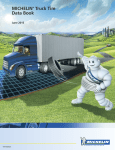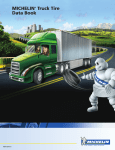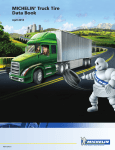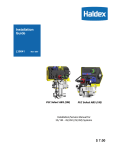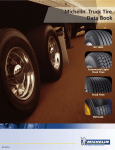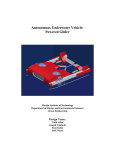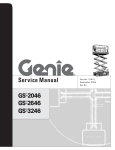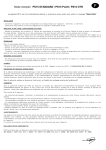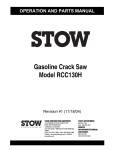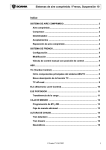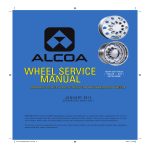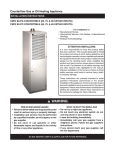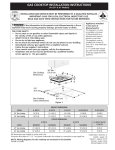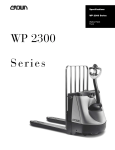Download Retreading - Goodyear Truck
Transcript
Retreading S E C T I O N Retreading The purpose of this Recommended Practice is to provide guidelines for the evaluation and selection of a retread supplier for truck tires. 86 E L E V E N S E C T I O N E L E V E N INTRODUCTION Tire retreading is a manufacturing process. Therefore, any retreaded tire is only as good as the workmanship and the quality control in the plant that manufactured it. To thoroughly evaluate a retread supplier, one must look at both the product and service. For these reasons, a plant visit is important in the selection of a retreader. PLANNING A RETREAD PLANT VISIT Prior to a plant visit, a few items should be considered. These may affect whether the retreader in question qualifies as a prospective supplier. These considerations include: 1. Does the retreader use quality products and procedures from a quality tread rubber manufacturer providing assistance to the retreader, ie: a. Production associate training b. Q.A. & technical assistance c. Plant certification 2. Does the retreader offer any of the following services you may need? a. Pick-up and delivery of tires b. Flat repair c. National account program d. Tire mounting and demounting e. 24-hour road service 3. Is the retreader making repairs: a. To both bias and radial casings? b. To all types and levels of tire injuries: spot repairs, bead repairs, reinforcements, and section repairs? 4. What is the retreader’s turn-around time? Seven day turn-around is typical. 5. Does the retreader define warranty Retreading PLANT INSPECTION policy on both retreading and repairs? Is there any casing warranty? When the retreader has satisfied that it can meet the needs in these areas, a visit to the plant for an evaluation of work methods and quality procedures is invaluable. A plant inspection is divided into eight areas of concern. They are in an order that should be convenient for a tour of the plant. Many of the questions raised will not have absolute or totally objective answers. Judgment, and the retreader’s response to questions, will provide the answers needed to rate any individual retread plant. It is suggested to reproduce the sections listed under “Plant Inspection” in this Recommended Practice for use in discussion with the retreader and its employees, and also reproduce the “Retread Plant Inspection Checklist” appearing at the end of this Recommended Practice to use during a retread plant visit. The checklist provides space to rate each item checked. 87 Plant Image 1. Overall plant appearance should be clean and orderly. 2. The plant must have adequate layout and space for effective handling of tires. 3. The facility should be well lighted and adequately ventilated. 4. The retread plant must have production capacity to handle your service needs. 5. The retread plant should be inspected and certified by an industry association or supplier. Casing Inspection The inspector’s job is to determine whether the used tire is retreadable as presented. If not, the inspector will usually make recommendations as to the disposition of the used tire: scrap; repair and then retread; return to the customer for adjustment consideration; etc. The ability to analyze worn and damaged tires is a skill usually acquired through experience and also requires a working knowledge of all the various steps of the retread process. Look for an experienced person in this position. 1. Inspection area must be well lighted. 2. Tires must be dry before being inspected. 3. Check to see whether the retreader is using any electronic, ultrasonic, or other “high-tech” inspection equipment. 4. Check the retreader’s system of tracking casings in process to ensure that all of your casings get back to you and that they are returned on schedule. Retreading S Casing Repairing The repair person’s job is to make structural repairs to damaged areas of the casing so the casing will be sound enough to last through a new tread life. 1. A separate, clean, well lighted area should be used for the repair area. 2. Wall charts should be posted showing procedures, patch usage, cure times, etc. Retreaders’ recommendations and procedures must be followed. 3. Repair materials must have current manufacture date codes or expiration date codes. Most repair materials have a shelf life and, ideally, should be stored in a cool, dry place. 4. All repair materials, cements, and supplies should be from the same manufacturer. It is a questionable practice to mix brands since not all products are compatible. 5. The retreader should identify repairs. (Retread plant name, date of repair, etc.) 6. Check to see that the repair shop is using the proper RPM hand buffing tools. a. A high RPM grinder is used for grinding steel. b. A low speed grinder is used on rubber. Use of a higher RPM tool will scorch the rubber, reducing adhesion. (Gummy rubber build-up on buffing rasp and smoke generated at the buffed surface are indications of scorching.) E C T I O N Buffing The buffing operation is used to size, shape, and texturize the crown of the casing in preparation for the application of a new tread. 1. All casings must be buffed to a predetermined: a. Crown width b. Crown radius c. Specified remaining undertread d. Symmetrical profile e. Diameter and bead to bead dimensions in mold cure systems 2. Buffers should be computer or template controlled. Buffer operators should not override computer programs or templates. 3. Wall charts, or other ready references, should be in use to determine the correct specification for each tire as referred to above. 4. All exposed cords (fabric or steel) must be “finished” to remove all fuzz and frayed ends. 5. All exposed cords (fabric or steel) should be coated with cement or other similar treatment promptly after completion of the buffing process. Steel cords must be coated within 15 minutes. 6. All untexturized areas such as tread grooves and irregular wear spots must be hand-treated to remove oxidation and surface dirt. 7. Buffing rasps should not be smoking excessively. This would be an indication of scorching and will result in poor adhesion. 8. Buff texture must be consistent with Rubber Manufacturers Association www.rma.com guidelines. See the RMA buffed texture chart. 9. Buffed tires must be handled in such a way as to ensure the buffed surface is not contaminated. 88 E L E V E N After Buff Preparation Items listed in this category include a number of interim steps between the major operations of buffing and tread application. Depending upon individual retread plant procedures, these steps might be performed individually, or as part of the repairing, buffing, or tread application steps. 1. An after-buff inspection should be performed to ensure the buffing process has not uncovered any previously unnoticed defects. 2. All holes, cuts, and penetrations must be probed to determine the severity of the injury and to ensure that all foreign material has been removed. 3. Buzz-out/skive-out. Note that this is the single most neglected or mishandled detail and one of the major causes of retread failures. All dirt, rust, and foreign material must be removed; all separated and/or laminated rubber must be removed – leaving a clean, solid surface for the filler material to adhere to. Any buzzout that exceeds the specified limits must be treated as a section repair. 4. Tires must be measured for proper mold fit or tread length in the case of some pre-cure methods. 5. Cement is used to enhance the adhesion between the new tread and the prepared casing. a. The tire should be clean before cementing. b. Adequate drying time must be allowed prior to tread application. c. Cement container must be protected from air supply line moisture and oil contamination. d. Check manufacturer’s date code or expiration date on cement container. Cements have a shelf life and must be kept fresh. e. The “in use” cement container must be kept mixed while being used to eliminate the possibility of solid settling out from the mixture. S E C T I O N Tread Application Tread application is the fitting of new tread rubber (which will become the new tread) onto the prepared casing. This rubber must be the correct width and thickness. It must be centered and it must be circumferentially consistent. 1. All buzz-outs should be filled flush with the buffed surface. 2. All exposed cord (fabric or steel) should be covered with cushion gum before the tread rubber is applied. 3. Check to see what brand, product line, and grade of tread rubber is being used. It is the retreader’s responsibility to notify his customers if this specification is changed. 4. Raw materials (tread rubber, cushion, etc.) must be fresh. Check the manufacturer’s date code or expiration date code on the container, and ideally, it should be stored in a cool, dry area. 5. With pre-cure treads there should be no more than two splices per tire. Observe the procedures and materials used for making tread splices for quality. 6. Short tread pieces (18” or less) should not be used to make splices. 7. With pre-cure tread application, “stitching” must be performed in such a way as to eliminate trapped air pockets. 8. Adhesive surfaces of tread rubber and cushion, and the buffed surface of the tire, must be kept free of contamination from hands and other sources. E L E V E N Curing There are two popular cure systems: 1. Mold Cure. Tread rubber is applied to the tire uncured. The prepared tire is placed in a mold (matrix) which imprints the tread pattern as the rubber is cured directly on the casing. 2. Pre-Cure. The previously cured tread rubber, with the tread design already formed, is applied to the tire with a thin layer of uncured cushion gum on its base to serve as an adhesive. The assembly is then placed in a heated, pressurized chamber where the cushion gum is cured to both the tread rubber and the casing, forming the bond between the two. 3. Time, temperature, and pressure are the three requirements of any retread cure system. Increasing or decreasing any of these factors from an optimum level will affect such things as tread adhesion, mileage, and casing life. The optimum time/temperature specification is determined by completing a thermocouple test in that particular curing equipment. a. Check to see if the retreader has had thermocouple tests made in his equipment. b. Ask to see what control systems or procedures are used to ensure that all tires are cured at the correct temperature, pressure, and time period. 4. All envelopes, diaphragms, and curing tubes must be leak free. 5. Check for steam and air leaks which may contribute to improper cure. 6. Tires must be stored in such a manner as to avoid distortion of the tread and/or casing before curing and immediately after. 7. Wicking material used with pre-cure systems must not be stapled into the tire sidewall or bead. Sidewalls and beads are not designed to accept 89 Retreading staples. Staples may penetrate the tubeless liner, creating air leaks. Holes from staples can allow moisture to enter and create rusting of the steel body in steel cord tires. Final Inspection & Finish After curing, a final inspection should be made of the finished retread. At this time, the finished tire may be trimmed of rubber flashing or overflow, painted, and tagged for delivery. 1. The inspection area must be well lighted. 2. The tire must be inspected on a spreader. 3. It is recommended that tires be inspected immediately after completion of the cure cycle, while still hot. Separations and other flaws that are visible while hot may disappear as the tire cools. 4. The inside of the tire must be inspected to ensure that all patches are properly bonded and that no bubbles, dimples, or buckles are evident in the patch or tire liner. 5. The outside of the tire should be inspected for appearance. 6. All staples must be removed from precure tread splices and wicking material. 7. Check to see that the DOT identification number has been applied to the tire. Ideally, the DOT number should be located away from the bulge width of the tire so it will not be scuffed off in service. 8. All rejected returned-as-received (RAR) casings should have the rejection cause marked on the tire with the area of injury clearly identified. 9. Finished retreads should be painted and all crayon marks should be painted over to give the final product an appealing appearance. Retreading S E C T I O N E L E V E N DEFINITIONS Base Width – A measurement of that portion of the tread rubber that joins to the buffed surface of the worn tire. Tread Cracks (Channel or Groove) – Cracks in the base of the tread grooves or voids. Beads – The anchoring part of the tire that is shaped to fit the tim. Made of high tensile steel wires wrapped and reinforced by the plies. Buckled – Any gross distortion of the tire body or tread area evidenced by wrinkling on the inside of the casing. Bead Sealing Area – The flat area and heel area of the bead that contacts the rim. With tubeless tires, the bead area seals to the rim and rim flange to retain air. Belted Bias Tires – Tires constructed so the ply cords extend from bead to bead and are laid at alternate angles substantially less than 90˚ to the centerline of the tread. On top of the body plies are two or more belt plies extending approximately from shoulder to shoulder running circumferentially around the tire at alternate angles. Bias Ply Tires – Tires constructed so the ply cords extend from bead to bead and are laid at alternate angles substantially less than 90˚ to the centerline of the tread. Body Plies – Layers of rubber-coated parallel cords extending from bead to bead. Breaks (Cracks) – A surface opening extending into or through the plies. Flex Breaks – A break into or through one or more plies, usually parallel to the beads. Impact Breaks – A star- or X-shaped or diagonal break into or through plies, usually visible from the inside of the tire. Radial Crack – A crack in the outer surface of the tire, usually in the sidewall area proceeding perpendicular towards the bead. Buffed Contour – The shape of the buffed tire that usually includes a specified radius and width. Buffed Radius – A measure of the buffed surface curvature from shoulder to shoulder. Buffed Texture – That surface produced by buffing, rasping, or cutting as defined by The Rubber Manufacturers Association, “Buffed Textures” (RMA Shop Bulletin No. 29, www.rma.org). Casing – The complete tire structure. Cement – An adhesive compound used to provide building tack. May be brushed or sprayed on the buffed surface. Check Template – A precut pattern used to determine the contour of a buffed tire to check compatibility to a matrix. Cords – The individual strands forming the plies in a tire. Cross Section – The section width of a tire casing. Cure – The process of vulcanization of rubber by applying heat and pressure for a specified time. Curing Tubes – Special tubes placed within the tire while curing. Diaphragm – A flexible sheet used to encompass part or all of a tire during 90 retreading in some processes. Gauge – Thickness, usually expressed in thirty-seconds of an inch, by the decimal system, or in millimeters in the metric system. Injuries – A break or cut of any shape caused by a penetrating object or severe scuff or impact. Injury Size – Widest opening in the cord body after skiving and buffing. Inner Liner – The tubeless tire inner surface used to retain the inflation media. Kinked (Beads) – A sharp permanent bend in the bead wires at one or more points around the circumference of the bead. Load Range – Specified as a letter (A, B, C, etc.) to identify a given size tire with its load and inflation limits when used in a specific type of service as defined in Tire and Rim Association, Inc. (or equivalent) yearbooks. Matrix – Aluminum, rubber, or steel rings or segments that form the cavity in which a tire retread is cured and with which the tread design is formed. Nail Hole – A penetration caused by a small, sharp object, 3/8 inch maximum diameter. Outside Steam Bag – A flexible bag, usually reinforced, used to encompass the tread and tire shoulders of a tire being retreaded or repaired. Plies – Layers of rubber-coated parallel cords. S E C T I O N Protector Ply – A ply added primarily for casing protection which in some cases may be removed during retreading. Radial Tire – A tire that has ply cords from bead to bead extending at about 90˚ to the centerline of the tread. On top of the body plies are two or more belt plies of rubber-coated cords extending approximately from shoulder to shoulder and running circumferentially around the tire at alternate angles at substantially less than the ply cord angle. Reinforcement (Repair) – Any material, usually rubber and fabric, vulcanized to a tire to add strength to the tire cord body at an injury. Repairs to over 25% of plies usually require reinforcement. Repairs of more than 75% of plies are usually called section repairs. Repair Material – Any rubber compound or patch material used to make repairs. Repairing – Reconditioning of portions of tires injured by punctures, cuts, breaks, cracks, etc. These repairs restore strength for additional safe service (See Reinforcement, Spot, Sections, Nail Holes). Retreading (Recapping) E L E V E N Precured Tread Retreading – Replacement of the worn tread areas with pre-vulcanized treads containing the tread design already cured in. Sections – Reinforced repairs made to a casing where an injury larger than a nail hole extends through more than 75% of the plies or through the casing in the tread or sidewall areas. Separation – Lack of adhesion or cohesion between any adjacent materials in a tire. Retreading Splices – A junction of the ends of any tire components. Spot (Repair) – The replacement of rubber only in an injury that penetrated to no more than 25% of the body plies in a radial tire. Rubber replacement only. Stitching – A method used to both remove trapped air and improve rubber contact for better adhesion. Synthetic Rubber – Man-made rubber. Texture – (See Buffed Texture) Tread Separation – Pulling away of the tread from the tire body. Tread – That portion of a tire that comes in contact with the road. Retread Separation – A separation between the tread rubber and the buffed tire casing. Tread Design – The non-skid pattern or design on the tread of a tire. Ply Separation – A separation between adjacent layers of cords (plies). Bead Separation – A breakdown of the bond between components in the bead area. Belt Edge Separation – A breakdown of the bond between components near the edge of the belt plies. Full Treading – Replacement of the worn tread with rubber extending over the shoulders. Shoulder – The upper sidewall areas of the tire casing immediately adjacent to the tread area. Top Treading – Replacement of the worn tread area only. Sidewall – That portion of the tire casing between the tread and bead. Bead-To-Bead Retreading – Replacement of the worn tread area and sidewall rubber extending to the bead. Skive – Removal of damaged material prior to making a repair. 91 Tread Grooves – The space between two adjacent tread ribs, lugs, or bars. Undertread (Replacement) – The rubber between the base of the tread groove and the buffed surface. Vulcanization – A chemical reaction which takes place under appropriate time, temperature and pressure and develops desirable characteristics and properties. (See Cure) Weather Checking – Tire sidewall surface crazing or cracking attributable to aging and atmospheric conditions rather than to flexing. Wicking – A capillary action caused by fabrics or cords that allows air to escape from the tire casing or from under an envelope. S Retreading E E C T I O N L E V E N RETREAD PLANT INSPECTION CHECKLIST PLANT: ____________________________________________________________ DATE: ____________________________ INSPECTOR(S): __________________________________________________________________________________________ NOT ACCEPTABLE ACCEPTABLE Plant Image A. B. C. D. E. F. G. H. Appearance Space and layout Lighting Ventilation Production capacity Outside certification Material storage Evidence of training Casing Inspection A. B. C. D. Lighting Dry casings Repairs removed Casing I.D./tracking Casing Repairing A. B. C. D. E. F. G. Location and lighting Repair information/procedures Material shelf life dates Material storage Single brand materials Repair I.D. Tool RPMs Buffing A. B. C. D. E. F. G. H. I. Buffed dimensions, profile Specification information Exposed cords finished Exposed cords cementing Texturize unbuffed areas Mold fit measurement Rasp condition/smoking Buff texture Handling, cleanliness 92 COMMENTS S E C T I O N E L E V E N ACCEPTABLE After-Buff Preparation A. B. C. D. E. Holes/cuts probed Buzz-out limits – Bias – Radial Cement application Cement dry time Cement shelf life Tread Application A. B. C. D. Buzz-outs filled Tread rubber manufacturer brand/grade Spliced tread rubber – 2 splices maximum – minimum 120˚ spacing Handling/cleanliness Curing A. B. C. D. E. Thermocouple tests Controls: pressure, temperature, and time Air/steam leaks Tire storage–distortion free Staples in tread of tire only Final Inspection A. B. C. D. E. F. Lighting Inspect on spreader Inspect hot Staples removed DOT serial number RAR identification 93 NOT ACCEPTABLE Retreading COMMENTS Miscellaneous S E C T I O N Miscellaneous The following section explains the use of chains on radial truck tires. Chain use is designed to offer additional traction, providing the chains and tires are matched appropriately for size and fit. General precautions to tire siping, dynamometer testing and mixing radial and bias ply tires are also addressed. Finally, this section explains the variances in sound levels produced by radial truck tires, and the conditions under which truck noise occurs. 94 T W E L V E S E C T I O N USE OF CHAINS ON RADIAL TRUCK TIRES The use of tire chains can be helpful in providing additional traction in severe weather conditions (such as ice and heavy snow) especially when traveling in hilly or mountainous terrain. Tire chains can be used safely and successfully with Goodyear radial truck tires provided several simple and important points are followed. Always select chains that are specifically designed for radial tires. These chains normally have shorter cross chains than older designs and allow the position of the side chains to be higher on the tire sidewall. This is out of the high-flex sidewall area of a radial tire and results in less susceptibility to sidewall damage. Be sure to use the proper chain size for the tire on which it is being attached. Tighten chains when they are first applied, then after a short run-in period, readjust to ensure a continued snug fit on radial tires. Serious sidewall damage may result from loose chains. Check for adequate dual spacing, especially if using single tire chains on each tire of a dual assembly. The greater deflection of the radial tire may require more dual spacing in marginally-spaced dual assemblies. Finally, always remove chains as soon as they are no longer needed. T W E L V E Miscellaneous TIRE SIPING Tire siping is a process of making small knife-like slits in the tread rubber surface. Normally this is accomplished by a machine that uses sharp, highspeed rotating discs to make cuts that are at an angle of 90° to the circumference of the tread. Siping cuts are normally controlled so they are spaced a specific distance apart from one another. They also will vary in depth across the tread face. Proponents of tread siping have claimed various performance improvements for truck tires. These claims include improved treadwear and reduced irregular wear. Also, it is often claimed that siping improves traction for winter and wet driving conditions on certain road types. At present, the majority of truck tire siping is done in the westernmost Midwest states and the Northwest corridor. It is popular in certain areas, and especially during the winter months, to sipe both steer and drive, and sometimes trailer tires. Goodyear’s position on siping is that it may, under certain operating conditions, improve tire performance. However, under the vast majority of truck operating conditions, new tires are designed and produced with tread patterns and tread compounds that do not require tread siping to give satisfactory performance. Actual testing indicates that siping may improve the tire’s resistance to irregular wear on free-rolling wheel positions that are susceptible to irregular wear due to the combination of operating service and tire application. Specifically, siping may help reduce irregular wear on trailer axles where light, one-way loads are encountered, such as grain trailers or belly dumps that operate under extreme load variations from unloaded to loaded conditions. 95 On the other hand, siping is generally believed to detract from treadwear on lug type tires used on drive-wheel position. This is because siping tends to break up the tread pattern and cause increased bending of the tread elements. This results in faster wear due to increased scuffing as the tire goes through its footprint under torque. The effect tread siping has on tire performance can vary considerably with the particular tire pattern being siped. For example, in a heavily bladed tread pattern it is believed that siping in the original tread state could hurt treadwear. Other tread patterns, such as those having a much higher net-to-gross footprint area, might be more adaptable for siping under the service conditions discussed earlier. If a customer chooses to sipe his Goodyear tires, we strongly recommend that he pay close attention to the type of siping used. Specifically, our experience is that siping should be performed laterally across the tread, although angles that vary somewhat from this might also be acceptable. However, to the best of our knowledge, siping that is more or less circumferential has not been demonstrated to be successful. Also, our experience shows that siping with varying depth across the face of the tread usually yields better results than constant depth siping. This also appears to provide the minimum risk for increasing the tire’s susceptibility to tread rubber chunking. It is important to note that the Goodyear warranty provides protection for the user against failures from workmanship or material conditions. If a tire failure occurs because of a condition beyond Goodyear’s control, such as siping, the warranty is null and void. Miscellaneous S In recent years, a number of retread rubber manufacturers have produced precure tread rubber that is siped when molded. Various claims of improved treadwear, fuel economy, etc, have been made. Our experience indicates that while these claims may be true in specific instances, it is largely a matter of siping the tread in such a way that is compatible with the particular tread rubber compound and tread pattern design being used. In other words, if tread siping is considered an integral part of the manufacture of new tread rubber at the outset, the siping can be more or less customized to the type of rubber and type of pattern so that performance can be optimized. In summary, tire siping may have certain performance advantages in improved treadwear and/or traction; however, these can be expected to vary considerably, depending on the particular type of tread rubber, the tread pattern, and the service conditions in which the tire is used. A customer considering siping tires should consult the new tire or retread rubber manufacturer to discuss appropriate siping machinery and techniques for the individual situation. E C T I O N T DYNAMOMETER TESTS MIXING RADIAL AND BIAS PLY TIRES Dynamometers are used by truck manufacturers, and frequently by truck distributors or large fleet operators, to test the engines and other parts of the driveline. Dynamometer rolls vary in size from 8-5/8-inch to 50-inches. The smaller rolls have a greater potential for damaging the tires. During a dynamometer check, there is little weight on the tires and only a small area of the tread face (usually the center rib or center portion of the tread) is in contact with the roll. Excessive heat builds up in this small area. If the test runs too long, the excessive heat can damage the tire to the point where it could fail later on the highway. The maximum safe time for running tires on a dynamometer roll varies with the roll diameter, speed, the power or torque transmitted from the tire to the roll, and, to some extent, the load and inflation. Figure 12.1 shows general rules for limiting the time for maximum power testing. Due to differences in cornering force characteristics and spring rates, the best tire and vehicle performance will be obtained by applying tires of the same size and construction (radial ply/bias ply) to all vehicle wheel positions. However, different tire constructions are permitted on the steer, drive, and trailer axles of two-axle, tandem, and multiple-axle combinations when the following rules are observed. • Never mix different tire sizes or tire constructions on the same axle. • If radial tires are mixed with bias tires, the best handling will be obtained with the bias tires on the steer axle. • Bias or radial tires may be used on either axle of two-axle vehicles, providing the vehicle has dual rear wheels or is equipped with Super Single wide-base tires. • Either bias or radial tires may be used on the steering axle of vehicles with three or more axles. Either all bias or all radial tires should be used on the nonsteering axles. • Never mix bias and radial tires in a tandem or multiple axle combination. Always check with the vehicle manufacturer before changing tire size or construction on any vehicle. Carefully evaluate performance changes caused by tire size or construction changes before putting the vehicle back into service. 50 – 60 MPH – Time Limit at Max Power Roll Dia 8 5/8'' 18'' - 20'' 30'' - 36'' 48'' - 50'' 3 Min 5 Min 10 Min 15 Min Figure 12.1 For 50 percent power, the time can be doubled. For 25 percent power, the time can be quadrupled. 96 W E L V E S T E C T I O N Miscellaneous W E L V E NOISE Tires are one source of noise emitted by a truck operating at speeds above 35 MPH on a highway. In addition to the tires, other major sources of noise are: • Engine • Radiator fan • Engine exhaust • Engine air intake • Driveline • Aerodynamics (wind noise) Noise is defined as a disagreeable sound. Pressure waves in the air produce sound. The human ear is designed to sense these pressure waves and transmit signals to the brain indicating the magnitude and characteristics of the sound. The ear mechanism can detect very faint sounds with very low air pressure energy levels and yet can detect and withstand relatively loud sounds with high energy levels without becoming damaged. To accomplish this wide range of hearing, the ear mechanism/brain response is not directly proportional to the sound pressure, but is less sensitive at the louder end of the range. The total noise output of a truck is usually measured with an instrument called a sound level meter. The input to the sound level meter is through a microphone that is placed nominally 50 feet from the center of the highway lane that is being monitored. The sound level meter has electronic circuitry designed to approximate the human auditory system. Thus, the input is varying air pressure caused by the sound — through a microphone — and the output is a value indicated on a scale that gives the sound level of the noise. The sound level or more precisely, the sound pressure level, indicates the degree of loudness to the human ear of a given sound. 400 300 Measured Sound Pressure Reference Sound Pressure Sound Level = 20 LOG10 Bias Ply Production Cross Rib Note: The reference pressure is usually taken as the sound pressure at the threshold of hearing: the quietest sound that can be heard, 0.0002 microbar of pressure. 200 Radial Cross Bias Ply Rib Radial Rib 100 68 70 72 74 76 78 80 Sound Level Decibels (A) Figure 12.2 Relative sound pressure vs. sound level in dB(A) from SAE J57 tests. Sound level units are measured in decibels, abbreviated dB. Since the human ear does not respond the same for all frequencies of sound, the sound level meter has been modified to agree closely with the frequency response of the human auditory system. When the frequency adjustments are included, the suffix (A) is added to the dB unit: dB(A). The relationship of sound pressure to sound level in the region caused by the tires of a truck is shown in a relative fashion by the curve in Figure 12.2. Note the relative increase in noise, going from the relatively non-aggressive radial rib tire to the bias ply rib tire; to the radial cross rib; to the bias ply cross rib tire. Also note the nature of the curve wherein greater changes in sound pressure are required to cause a given change in sound level at the higher sound pressures than at the lower sound pressures. 97 The data for the curve were obtained from standard SAE J57 tests using a truck with four test tires on drive axle and two rib tires on steer axle. The test consisted of a 50-mph coast-by with microphone at 50 feet from the line of travel. When several sources cause sound waves to impinge on the ear simultaneously, the ear perceives the sum total of sound air pressure on the ear drum; the pressures are additive. However, the sound level perceived by the overall auditory system is increased only according to the logarithmic rule demonstrated by the curve. Therefore, when sounds are emitted by various sources in a truck, the combined effect can be obtained by adding sound pressures and then converting the total sound pressure to dB(A). If individual sources of sound have already been computed or measured in dB(A), the combinations of these sounds in terms of dB(A) cannot be obtained by addition of the individual dB(A) values. S Miscellaneous Typical sound levels of various over-the-road truck components and the effect on total sound level of combining these noise sources are shown in Figure 12.3. The tire noise value listed assumes the use of eight bias ply cross-rib drive tires on the truck. Speeds Above 35 MPH – Six Predominant Noise Sources Engine 80 Fan 79 Exhaust 80 Intake 80 82 86 83 Driveline Tires 83 87-90 dB(A) 75-86 Figure 12.3 Combining noise sources. Typical methods used to reduce truck noise to meet limits prescribed by law are as follows: • Reduce speed • Retrofit equipment • Improve maintenance • Remove irregularly worn tires • Restrict lug tires to drive axles • Use radial tires on all axles • Use rib tires on all axles • 87-90 dB(A) Laws on noise are established by the Federal government, and are administered by the Environmental Protection Agency (EPA). Active enforcement, however, generally is the responsibility of state highway authorities. E C T I O N Since the enactment of the Noise Control Act of 1972, the EPA has been empowered to issue regulations controlling the operational noise levels of interstate rail and common carriers, and the noise emissions of newly manufactured products. To do this, the EPA must identify a certain area of commercial endeavor or a certain product as a “major noise source.” It then has the authority to pursue regulatory activity to control and monitor that area or product. Early on, the railroads, airports, certain manufacturing operations, and a host of other activities were identified as major noise sources in need of regulatory attention. The Agency specifically labeled medium and heavy trucks as significant sources of environmental noise and has set up standards for the testing and control of the “total vehicle noise emission package.” These standards, known as the Interstate Motor Carrier Noise Emission Standards, are contained in Volume 40, Parts 202 and 205, of the Code of Federal Regulations. They have been in force since 1975, and apply to all vehicles in over-the-highway service as well as to newly manufactured vehicles. They set definite limits for total noise levels at various speeds and under stationary conditions. The legislation for in-service interstate motor carriers requires that overall external noise levels for trucks manufactured previous to the 1986 model year not exceed the following values, measured at a distance of 50 feet from the vehicle centerline: • 90 dB(A) on highways at speeds greater than 35 mph • 86 dB(A) on highways at speeds of 35 mph or less • 88 dB(A) during stationary runup at governed engine rpm 98 T W E L V E For trucks of 1986 model year manufacture and later, the standard requires that the external noise level values must not exceed: • 87 dB(A) on highways at speeds greater than 35 mph • 83 dB(A) on highways at speeds of 35 mph or less • 85 dB(A) during stationary runup at governed engine rpm New medium and heavy duty trucks (vehicles with GVWR of 10,000 lbs. or greater) must meet noise emission standards based on a vehicle acceleration and pass-by test at speeds of up to but not exceeding 35 mph. The noise measurement is taken at a distance of 50 feet from the centerline of vehicle travel, and the test is performed by the vehicle manufacturer himself and certified to the EPA. For medium and heavy duty trucks produced prior to January 1, 1988, manufacturers had to test their vehicles to a maximum external noise level of 83 dB(A). For trucks manufactured after January 1, 1988, the maximum external noise level permitted is 80 dB(A). S E C T I O N T W E L V E Miscellaneous TIRE STORAGE RECOMMENDATIONS For Tires Not Installed on Vehicles 1. Oil, Solvents and Grease Mounted or unmounted tires should never be stored on oily floors or otherwise in contact with solvents, oil or grease. Nor should tires be stored in the same or adjoining rooms with volatile solvents. These solids, liquids or vapors are readily absorbed in rubber and will damage and weaken it. 2. Ozone Mounted and unmounted tires should be stored away from electrical devices such as motors, generators, arc welders and switches because they are active sources of ozone. Ozone attacks rubber causing it to crack perpendicular to any applied stress. Such cracking exposes the new rubber surface at the base of the crack to greater stress and consequently to more severe ozone attack until eventually the cracks can penetrate to the carcass where continued rubber degradation could cause carcass failure. Minor, ozone induced, surface cracks will seldom cause tire failure, but can form an access route for foreign material to penetrate the carcass once the tire is placed in service. 3. Heat and Light Tires should be stored in a cool place, away from direct sunlight or strong artificial light. Both heat and light are sources of oxidation of the tire surfaces. The oxidation is characterized by a “crazed” or “alligatored” surface which does not penetrate the rubber deeply. The severity of the oxidation is, of course, a time- and temperature-dependent variable. Long term storage at ambient temperatures have been equated to short term storage at elevated temperatures. For instance, three days storage at 158˚ F causes approximately the same loss in tensile strength as three years storage at 75˚ F. Oxidation may cause sufficient damage to the inside of an unmounted tire as to cause early tube failure or a slow leak. 4. Undue Stress in Storage If possible, tires should be stored vertically on treads. Severely stressed and distorted tires are subject to much greater damage from solvent, ozone or oxidative attack than those which are not stressed or are stressed minimally and uniformly. Unmounted tires stacked horizontally (on sidewall) should be piled symmetrically and never so high as to cause severe distortion to the bottom tire. Tires that are mounted on rims but not on vehicles should follow the same recommendations as for unmounted tires. 5. Foreign Material - Dirt, Water Unmounted tires should be stored under a waterproof covering. Dirt is not harmful to a tire. However, dirt on the inside of a tire placed in service can cause early tube failure or a slow leak. Water on the inside of a tire in service can be turned into steam which can quickly destroy the strength of both the rubber and the textile members of the tire. Additionally, water and dirt inside a tubeless tire can cause corrosion to tubeless rims and plug tubeless values, both a source of potential tire failure. Foreign material on the tire bead seat could affect air seal and cause air loss. 6. Inflation If tires are mounted on rims and inflated, pressure should be maintained at 10 PSI. If tires are inflated and put in storage during warm weather, the initial inflation should be about 15 PSI to offset the drop in pressure which will occur during the cold weather months. 7. Protective Cover If tires are stacked, first lay a foundation of clean wood to protect them from dirt, oil, grease, etc. Tires should be covered with an opaque or black polyethylene film. PVC or any other clear film is not satisfactory. The polyethylene film will protect against ozone generated by 99 electrical sources and cut down on air circulation which will minimize both the available oxygen and ozone which degrade rubber. 8. Do Not Use Paint to Preserve Tires For Tires Installed on Vehicles 1. The storage area surface under each vehicle should be firm, reasonably level, well drained and free of all oil, fuel or grease. Clean 1/4'' - 3/4'' gravel under each tire is desirable if the area is not paved. Storage should not be permitted on blacktop or oil stabilized surfaces. 2. When storage longer than 6 months is anticipated, the vehicle should be blocked up so weight does not rest on the tires and inflation pressure reduced to 15 PSI. Storage of such vehicles should be under cover if possible. Otherwise, tires should be protected from elements by an opaque waterproof covering. 3. If it is not possible to block up the vehicle, inflation pressure in the tires should be increased to 25% above the inflation required for the actual load on the tire in the storage condition. 4. Vehicles should not be moved during extremely cold weather. Under moderate temperature conditions, vehicles may be moved if necessary. 5. Inflation in the tires must be adjusted to the recommended service pressure before shipping or putting a stored vehicle into service. 6. Both tires and vehicles should be used on a first-in, first-out basis to avoid excessive aging due to storage. 7. Based on varying weather conditions, if tires are stored uncovered on vehicles under load, some weathering may occur at approximately one year storage period. Miscellaneous S E C T I O N WHEN DOES THE WARRANTY END A tire has delivered its full original tread life and this warranty ends when the tread wear indicators become visible, or five (5) years from he date of original tire manufacture or original new tire purchase date (whichever comes first). How Do I Know When My Tires Were Maufactured? Tires with a Department of Transportation (DOT) number ending with 0100 or later were manufactured after 1/1/2000. 0100 is the 4-digit production date in week-week-year-year format. 0100 means the tire was produced in the 1st week of 2000. Prior to January 2000, a 3-digit date code was used following a week-week-year format. thus, 019 means the tire was produced in the 1st week of 1999. TIRE SEALANTS AND BALANCE MATERIALS There are many vendors that sell aftermarket tire sealants and balance materials that can be added or pumped into a tire. Goodyear does not endorse any product, but if you wish to use such a product as either a sealant or tire balancer, the Goodyear warranty is voided if the material adversely affects the tire inner liner. 100 T W E L V E S E C T I O N T H I R T E E N Standards & Regulations Both truck tire manufacturers and truck tire users are covered by a number of federal and state regulations designed to assure the safety of the motoring public. Some of the more important requirements of these regulations are discussed in the following section, including Federal Motor Carrier Safety Regulations, Commercial Vehicle Safety Alliance and Regrooving/Tire Siping Regulations. 101 Standards & Regulations Standards & Regulations S E C T I O N T H I R T E E N FEDERAL MOTOR VEHICLE SAFETY STANDARDS TESTING AND CERTIFICATION The federal regulations which pertain to the performance and safety of truck tires fall generally into two categories. Those regulations which affect the testing, certification, and marking of newly manufactured tires are contained in Volume 49 of the Code of Federal Regulations (CFR), Part 571, and are referred to as “Federal Motor Vehicle Safety Standards.” Those which cover over-the-highway usage and application are contained in Volume 49 of the same Code, but in Parts 350 through 399, and are called “Federal Motor Carrier Safety Regulations.” The differentiation between newly manufactured items and over-the-highway usage is quite clear. Thus, a tire manufacturer is concerned with complying with the Motor Vehicle Safety Standards regarding testing, certification and markings, while the owner or operator of a vehicle who is using the tires in service must be in compliance with the Motor Carrier Safety Standards in regard to the application, usage and condition of those tires. Standard 119 makes demands beyond simply testing. For one thing, the tire must carry a serial code of up to eleven digits or characters on one sidewall indicating the name of the manufacturer, the producing plant, the tire size, the tire type (brand name, load range, sidewall description, etc.), and the week and year of production. This information becomes especially important for record keeping and recall work. For another, the tire must carry information clearly molded into the sidewall to give the consumer a variety of facts about the product, such as size, type, load range, generic names of materials, construction type, whether for single or dual usage, maximum load and inflation data, and of course the DOT symbol and serial code. The manufacturer must also include treadwear indicators evenly spaced around the circumference of the tire to indicate visually when the tire has worn to a tread depth of 2/32''. The regulations encompassed by the Federal Motor Vehicle Safety Standards for newly manufactured products are administered by the National Highway Traffic Safety Administration (NHTSA), a branch of the U. S. Department of Transportation (DOT). Those laws contained within the Federal Motor Carrier Safety Regulations are administered by the Federal Highway Administration (FHWA), also a branch of the DOT, and enforced by the Bureau of Motor Carrier Safety (BMCS), a sub-agency of the FHWA and one of the few true enforcement arms within the DOT. Part 571.119 of Volume 49 of the Code of Federal Regulations, known as Federal Motor Vehicle Safety Standard 119 (FMVSS 119), requires that a variety of tests be performed by a tire manufacturer to certify that a specific size of a tire line meets Federal safety requirements. The main purpose of this law is to ensure tire testing and certification to specific performance parameters in the areas of endurance and strength. By randomly sampling and laboratory testing tires in this manner during production periods, a tire manufacturer certifies that his product meets the minimum safety requirements established by law. He also properly qualifies his tires to carry the “DOT” stamping on the sidewall. Since this DOT marking must appear on any tire legally sold for over-the- highway use in the U.S., it becomes essential for a manufacturer to test and certify his tires to Motor Vehicle Safety Standard 119. The other Federal Motor Vehicle Safety Standard which effects truck tires is FMVSS 120, which spells out tire and rim selection and matching requirements for vehicle manufacturers. This standard is intended to ensure that when a consumer purchases a new vehicle, the total maximum load capacities on any axle are at least as great as the gross weight rating of that axle, so that the load carrying capacity of the tires is not exceeded so long as the vehicle is properly loaded. 102 Federal Motor Carrier SAFETY REGULATIONS TITLE 49 CODE OF FEDERAL REGULATIONS PARTS 40, 325, 383, 385, 386, 387, 390–397, 399 U.S. DEPARTMENT OF TRANSPORTATION FEDERAL HIGHWAY ADMINISTRATION SEPTEMBER, 1993 American Trucking Associations SUBPART G — MISCELLANEOUS PARTS AND ACCESSORIES §393.75 Tires. (a) No motor vehicle shall be operated on any tire that (1) has body ply or belt material exposed through the tread or sidewall, (2) has any tread or sidewall separation, (3) is flat or has an audible leak, or (4) has a cut to the extent that the ply or belt material is exposed. (b) Any tire on the front wheels of a bus, truck, or truck tractor shall have a tread groove pattern depth of at least 4/32 of an inch when measured at any point on a major tread groove. The measurements shall not be made where tie bars, humps, or fillets are located. (c) Except as provided in paragraph (b) of this section, tires shall have a tread groove pattern depth of at least 2/32 of an inch when measured in a major tread groove. The measurement shall not be made where tie bars, humps or fillets are located. (d) No bus shall be operated with regrooved, recapped or retreaded tires on the front wheels. (e) No truck or truck tractor shall be operated with regrooved tires on the S E C T I O N T H I R T E E N Standards & Regulations INSPECTION front wheels which have a load carrying capacity equal to or greater than that of 8.25-20 8 ply-rating tires. (f) Tire loading restrictions (except on manufactured homes). No motor vehicle (except manufactured homes, which are governed by paragraph (g) of this section) shall be operated with tires that carry a weight greater than that marked on the sidewall of the tire or, in the absence of such a marking, a weight greater than that specified for the tires in any of the publications of any of the organizations listed in Federal Motor Vehicle Safety Standard No. 119 (49 CFR 571.119, S5.1(b)) unless: (1) The vehicle is being operated under the terms of a special permit issued by the State; and (2) The vehicle is being operated at a reduced speed to compensate for the tire loading in excess of the manufacturer's rated capacity for the tire. In no case shall the speed exceed 80 km/hr (50 mph). (g)(1) Tire loading restrictions for manufactured homes built before January 1, 2002. Manufactured homes that are labeled pursuant to 24 CFR 3282.362(c)(2)(i) before January 1, 2002, must not be transported on tires that are loaded more than 18 percent over the load rating marked on the sidewall of the tire or, in the absence of such a marking, more than 18 percent over the load rating specified in any of the publications of any of the organizations listed in FMVSS No. 119 (49 CFR 571.119, S5.1(b)). Manufactured homes labeled before January 1, 2002, transported on tires overloaded by 9 percent or more must not be operated at speeds exceeding 80 km/hr (50 mph). (2) Tire loading restrictions for manufactured homes built on or after January 1, 2002. Manufactured homes that are labeled pursuant to 24 CFR 3282.362 (c)(2)(i) on or after January 1, 2002, must not be transported on tires loaded beyond the load rating marked on the sidewall of the tire or, in the absence of such a marking, the load rating specified in any of the publications of any of the organizations listed in FMVSS No. 119 (49 CFR 571.119, S5.1(b)). (h) Tire inflation pressure. (1) No motor vehicle shall be operated on a tire which has a cold inflation pressure less than that specified for the load being carried. (2) If the inflation pressure of the tire has been increased by heat because of the recent operation of the vehicle, the cold inflation pressure shall be estimated by subtracting the inflation buildup factor shown in Table 1 from the measured inflation pressure. Table I — Inflation pressure measurement correction for heat Minimum inflation pressure buildup Average speed of tire in previous hour 41 to 55 mph (66 to 88.5 km/hr) Tires with Tires with over 4,000 lbs. 4,000 lb. (1,814 kg) (1,814 kg) maximum load load rating rating or less 5 psi (34.5 kPa) 103 15 psi (103.4 kPa) A regular program of tire inspection is essential for the prevention of rapid air loss failures. At a minimum, tires should be inspected at the time of the regular preventive maintenance checks. The Bureau of Motor Carrier Safety recommends an inspection by the driver prior to every trip in its “Truck Driver’s Pre-trip Check List.” In any tire inspection routine, tires should be inspected for the following conditions. If any are found, the tire should be removed and repaired, retreaded or scrapped as the condition indicates. • Any blister, bump or raised portion anywhere on the surface of the tire tread or sidewall (other than a bump made by a repair). These indicate the start of internal separation. • Any cut that reaches to the belt or ply cords, or any cut that is large enough to grow in size and depth. • Any nail or puncturing object. • If any stone or object is held by a tread groove and is starting to drill into the tread base, remove the object. • Look for skid spots and irregular wear conditions and refer to the chapter on alignment, irregular wear, and rotation. The owner or operator should also be aware that the use of recapped, retreaded, or regrooved tires is restricted by the BMCS, Federal Motor Carrier Safety Regulations, and some state regulations, and that the Rubber Manufacturers Association recommends against their use in certain applications. In addition to the routine type of common-sense, owner-performed tire inspection just described, there are mandatory inspections which involve agents and agencies of the federal government. For example, the inspection of tires for defects is required by NHTSA Vehicle In Use Inspection Standards, and by BMCS, Federal Motor Carrier Safety Regulations. Part 396 of the Federal Motor Carrier Safety Regulations authorizes special agent personnel of the Federal Highway Standards & Regulations S E C T I O N T MINIMUM TREAD DEPTHS Administration, including Bureau of Motor Safety inspectors, to perform inspections of a motor carrier’s vehicles which are currently in operation. These inspections may be performed at a facility of the motor carrier (such as a terminal) or at some other location (such as on-highway) at the discretion of the inspector. The results of these inspections are recorded in a Driver-Equipment Compliance Check report. If the check is done at a location other than one of the motor carrier’s facilities, the driver is required to deliver this report to the motor carrier upon his arrival at the carrier’s next terminal, or to mail it to the carrier if he is not scheduled to be in a terminal within 24 hours after the time of the inspection. The motor carrier then has 15 days from the inspection date to correct any violations or defects, certify any action taken using Form MCS-63, and return the form to the BMCS office address indicated on the report. Part 397 of the same regulation requires that for the transport of hazardous materials, vehicles equipped with duals on any axle must have the tires inspected every two hours or 100 miles, whichever occurs first, for the duration of the trip. Minimum tread groove depths are specified for tire manufacturers under Federal Motor Vehicle Safety Standard 119, and for in-use applications by Federal Motor Carrier Safety Regulations, part 393.75. Under FMVSS 119, manufacturers must include tread depth indicators, commonly called “wear bars”, in six locations evenly spaced around the circumference of a highway truck tire, so that they become visible when 2/32'' of tread groove depth is remaining. 104 H I R T E E N COMMERCIAL VEHICLE SAFETY ALLIANCE (CVSA) Under FMCSR Part 393.75, operators are required to maintain at least 4/32'' of tread groove depth on the front tires of any bus, truck, or truck tractor covered by that law, and the standard 2/32'' remaining tread depth on the other wheel positions. In conjunction with the federally required tire inspections previously mentioned, much work has been done to promote commonly performed and recognized tire inspection criteria within the scope of the total vehicle inspection program in use by the Commercial Vehicle Safety Alliance (CVSA). The CVSA is a voluntary organization made up of states and provinces which have responsibility for commercial vehicle safety operations and which perform vehicle inspections and conduct other safety related programs. The aims of the organization are to maximize the utilization of commercial vehicle, driver and cargo inspection resources, to avoid duplication of effort, to expand the number of inspections performed on a regional basis, to advance uniformity of inspection, and to minimize delays in industry schedules which could result from this type of enforcement activity. The CVSA does not supersede or countermand any legally required inspection process or any state laws. It is simply a working agreement among member jurisdictions to use standardized procedures. It has gained widespread acceptance and has made great progress toward providing a common inspection program. CVSA members inspect vehicles on-highway and in terminals. Areas covered by a CVSA vehicle inspection are the driver (license, hours-of-service records, medical certificate), steering mechanism, brakes, brake lights/turn signals, drawbars, suspension, fifth wheels, air loss and warning, wheels and tires. Vehicles which pass the inspection are issued a CVSA decal, colored differently for each quarter of the year, and honored for the month of issuance plus the S E C T I O N T H I R T E E N Standards & Regulations REGROOVING/ TIRE SIPING following two months by all participating states and provinces. Criteria for the tire inspection portion of the CVSA inspection program recommends replacement of a tire with any of the following conditions: Steering Axle of Power Unit • Less than 2/32-inch tread depth at two, adjacent, major tread grooves anywhere on the tire. • Portion of breaker strip or casing ply visibe in tread. • Sidewall is cut, worn, or damaged thereby exposing ply cord. • Labeled “Not for Highway Use” or other marking excluding current application (Excluding farm/ off-road vehicles briefly on the road. • Bulge suggesting tread/sidewall separation. Exception: Bulge from section repair (sometimes identified by adjacent blue, triangular label) is not a defect unless higher than 3/8 inch. • Tire flat or has leak that’s felt or heard. • Mounted/inflated so tire contacts part of vehicle. • Tire overloaded, including overload resulting from under-inflation. Exception: Does not apply to special permit vehicle operated at a speed low enough to compensate for underinflation. Drive/Trail Tires Out of Service • 75 percent or more tread width loose or missing, in excess of 12 inches of tire’s circumference. • Less than 1/32 inch tread depth at two adjacent, major tread grooves at three separate locations on tire. With duals, both tires must have listed defect to warrant out-of-service judgement. • Tire flat or has leak that can be felt or heard. • Bias-ply tire with more than one ply exposed in tread area or sidewall, or when exposed area of top ply exceeds 2 square inches. With duals, both tires must have listed defect to warrant out-of-service judfgement. • Radial tire with two or more plies exposed in tread area, or damaged cords evident in sidewall or exposed area on sidewall exceeding 2 square inches. With dual, both tires must have listed defect to warrant out-ofservice judgement • Bulge suggesting tread/sidewall separation. Exception: Bulge from section repair (sometimes identified by adjacent blue, triangular label) is not a defect unless higher than 3/8 inch. • Mounted or inflated so tire contacts part of vehicle or in the case of a dual assembly, its mate. • Tire overloaded, including overload resulting from under-inflation. Exception: Does not apply to special permit vehicle operated at a speed low enough to compensate for underinflation. 105 Regrooving is used in certain types of service to extend the mileage obtainable from the original tire tread. Tires designed with sufficient undertread depth to permit regrooving are labeled on the sidewalls as regroovable. Undertread depth refers to the thickness of tread compound between the bottom of the original tread grooves and the top of the uppermost breaker or belt. The use of regrooving is more common in intra-state bus service than in trucking fleets. Goodyear recommends retreading radial tires for truck use rather than regrooving. If retreading is not practical, front tires can be regrooved and moved to trailers. Drive tires should be taken off when about 80 percent worn, the non-skid depth increased by regrooving, and then reapplied to the drive axle. Regrooving requires probing the depth of the undertread so that a minimum undertread depth of 3/32 inch remain below the newly cut groove. It is recommended that the local Goodyear representative be contacted for information if regrooving is being considered. Tire Siping For Traction Adding tire siping to new or partially worn rib tires for additional traction (as differentiated from regrooving worn tread for additional mileage) is an accepted practice for trucking fleets operating on and off the road. Partially worn radial lug tires can also benefit from regrooving the tread pattern down to 80% of the deepest portion of the original non-skid depth for added traction. Standards & Regulations S E C T I O N DOT Regulations On Regrooved Tire Purpose and Scope This part sets forth the conditions under which regrooved and regroovable tires manufactured or regrooved after the effective date of the regulation may be sold, offered for sale, introduced for sale or delivered for introduction into interstate commerce. Definitions (A) Regroovable tire means a tire, either original tread or retread, designed and constructed with sufficient tread material to permit renewal of the tread pattern or the generaton of a new tread patternin a manner which conforms to this part. (B) Regrooved tire means a tire, either original tread or retread, on which the tread pattern has been renewed or a new tread has been produced by cutting into the tread of a worn tire to a depth equal to or deeper than the molded original groove depth. Applicability (A) General. Except as provided in paragraph (B) of this section, this part applies to all motor vehicle regrooved or regroovable tires manufactured or regrooved after the effective date of the regulation. (B) Export. This part does not apply to regrooved or regroovable tires intended solely for export and so labeled or tagged. Requirements (A) Regrooved tires. (1) Except as permitted by paragraph (A)(2) of this section, no person shall sell, offer for sale, or introduce or deliver for introduction into interstate commerce regrooved tires produced by removing rubber from the surface of a worn tire tread to generate a new tread pattern. Any person who T regrooves tires and leases them to owners or operators of motor vehicles and any person who regrooves his own tires for use on motor vehicles is considered to be a person delivering for introduction into interstate commerce within the meaning of this part. (2) A regrooved tire may be sold, offered for sale, or introduced for sale or delivered for introduction into interstate commerce only if it conforms to each of the following requirements: (a) The tire being regrooved shall be a regroovable tire; (b) After regrooving, cord material below the grooves shall have a protective covering of tread material at least 3/32 inch thick; (c) After regrooving, the new grooves generated into the tread material and any residual original molded tread groove which is at or below the new regrooved depth shall have a minimum of 90 linear inches of tread edges per linear foot of the circumference; (d) After regrooving, the new groove width generated into the tread material shall be a minimum of 3/16 inch and a maximum of 5/16 inch; (e) After regrooving, all new grooves cut into the tread shall provide unobstructed fluid escape passages; and (f) After regrooving, the tire shall not contain any of the following defects, as determined by a visual examination of the tire either mounted on the rim, or dismounted, whichever is applicable: (i) Cracking which extends to the fabric. (ii) Groove cracks or wear extending to the fabric, or (iii) Evidence of ply, tread or sidewall separation. 106 H I R T E E N (g) If the tire is siped by cutting the tread surface without removing rubber, the tire cord material shall not be damaged as a result of the siping process, and no sipe shall be deeper than the original or retread groove depth. (B) Siped regroovable tires. No person shall sell, offer for sale, or introduce for sale or deliver for introduction into interstate commerce a regroovable tire that has been siped by cutting the tread surface without removing rubber if the tire cord material is damaged as a result of the siping process, or if the tire is siped deeper than the original or retread groove depth. Labeling of Regroovable Tires Each tire designed and constructed for regrooving shall be labeled on both sidewalls with the word “Regroovable” molded on or into the tire in raised or recessed letters 0.025 to 0.040 inch. The word “Regroovable” shall be in letters 0.38 to 0.50 inch in height and not less than 4 inches and not more than 6 inches in length. The lettering shall be located in the sidewall of the tire between the maximum section width and the bead in an area which will not be obstructed by the rim flange. See Page 102 (Subpart G Miscellaneous Parts and Accessories) for the Federal Motor Carriers Safety Regulatons regarding regrooved tires. LOAD RATINGS AND INFLATION DATA FOR RADIAL TRUCK TIRES Tubeless Tube Type Dual Tire Load Rating 7.50R16LT LT225/75R16 LT245/75R16 LT215/85R16 LT235/85R16 8.75R16.5LT 9.50R16.5LT 8R17.5 8.5R17.5 9R17.5HC 10R17.5 11R17.5HC 8R19.5 9R22.5 10R22.5 11R22.5 12R22.5 13R22.5 11R24.5 12R24.5 Load Range Load Range Load Range Load Range Load Range Load Range Load Range D E F G H J L 2140@65 2150@65 2381@65 2150@65 2381@65 2070@65 2445@65 2440@80 2470@80 2778@80 2470@80 2778@80 2360@80 2790@80 2755@85 5675@125* 4430@95 3970@110 4410@110 4850@110 5250@115 5750@105 5780@95 5800@110 6750@120 3415@110 3085@90 8.25R15 3660@105 10.00R15TR 2700@80 3375@110 3950@95 4875@100 8.25R20 9.00R20 10.00R20 11.00R20 6395@125 7160@125 7200@110 12.00R20 14.00R20 10.00R22 11.00R22 11.00R24 12.00R24 9610@105* 6000@105 6170@110 6720@110 7130@110 8100@110 215/75R17.5 225/70R19.5 245/70R19.5 265/70R19.5 255/70R22.5 245/75R22.5 265/75R22.5 295/75R22.5 295/80R22.5 315/80R22.5 4540@125* 3415@95 3875@85 4375@100 4750@105 5070@115 4410@110 4805@100 5675@100 6005@110 6610@115 7610@120 7160@110 13/80R20 285/75R24.5 7750@120* 5675@100 Single Tire Load Rating 7.50R16LT LT225/75R16 LT245/75R16 LT215/85R16 LT235/85R16 8.75R16.5LT 9.50R16.5LT 8R17.5 8.5R17.5 9R17.5HC 10R17.5 11R17.5HC 8R19.5 9R22.5 10R22.5 11R22.5 12R22.5 13R22.5 11R24.5 12R24.5 2440@65 2335@65 2623@65 2335@65 2623@65 2350@65 2780@65 2780@80 2680@80 3042@80 2680@80 3042@80 2680@80 3170@80 2835@85 3750@110 3195@90 8.25R15 4070@105 10.00R15TR 2800@80 8.25R20 9.00R20 10.00R20 11.00R20 3500@110 4500@105 5150@100 5680@115 6175@105 6590@105 6610@120 7390@120 6005@125* 6945@125 8270@125 8210@120 12.00R20 14.00R20 10.00R22 11.00R22 11.00R24 12.00R24 215/75R17.5 225/70R19.5 245/70R19.5 265/70R19.5 255/70R22.5 245/75R22.5 265/75R22.5 295/75R22.5 295/80R22.5 315/80R22.5 5050@105 4410@110 4675@110 5530@120 10960@115* 6430@105 7030@120 7660@120 8130@120 9230@120 4805@125* 3640@95 4080@85 4545@100 5000@105 5510@115 4675@110 5205@110 6175@110 8270@120 8050@110 9090@120 10000@130 13/80R20 14/80R20 365/80R20 285/75R24.5 385/65R22.5 425/65R22.5 445/65R22.5 Notes: 1. With above loads and inflations, the maximum speed is 65 MPH. 2. For ML tires, see Tire and Rim Year Book for separate ML table. 6610@120 7390@115 9000@120* 6175@110 9370@120 10500@110 12300@120 *55 MPH max. 107 TRUCK TYPE AND WEIGHT CLASS The vehicle icons on the following page depict examples of vehicles in each DOT classification 1-8 with corresponding load ranges. These classifications are guidelines in understanding the type of vehicle used for different applications by vehicle class. CLASS ONE 6,000 lbs. or less Full Size Pickup Mini Pickup Minivan SUV Utility Van Crew Size Pickup Full Size Pickup Mini Bus Minivan Step Van City Delivery Mini Bus Walk In City Delivery Conventional Van Landscape Utility Bucket City Delivery Large Walk In Beverage Rack School Bus Single Axle Van Stake Body City Transit Bus Furniture High Profile Semi Home Fuel Medium Semi Tractor Refuse Tow Cement Mixer Dump Fire Truck Fuel Heavy Semi Tractor Refrigerated Van Semi Sleeper Tour Bus Auto Transport Double Van Drop Frame Dry Bulk Dump Trailer Flatbed Flatbed Low Boy Logger Reefer Tanker Van Trailer CLASS TWO 6,001 to 10,000 lbs. Utility Van CLASS THREE 10,001 to 14,000 lbs. CLASS FOUR 14,001 to 16,000 lbs. Large Walk In CLASS FIVE 16,001 to 19,500 lbs. CLASS SIX 19,501 to 26,000 lbs. CLASS SEVEN 26,001 to 33,000 lbs. CLASS EIGHT 33,001 lbs. & over TRAILERS 108 INDEX Ackerman Steering Effect on Tire Wear........................................47 Alignment................................................43 Ackerman Steering Effect on Tire Wear ...........................................47 Camber...................................................46 Caster.....................................................46 Drive Axle Alignment ...............................48 In-Service Alignment Recommendations .................................49 Loaded vs. Unloaded Alignment Settings...............................................45 Steer Axle Alignment ................................45 Toe.........................................................46 Trailer Axle Alignment..............................49 Bearing Adjustment.................................55 Branding Tires .........................................35 Camber....................................................46 Caster.......................................................46 Center-Over-Injury Section Repairs ......85 Chains on Radial Truck Tires .................95 Collecting and Storing Tire Information ..................................35 Branding Tires.........................................35 Radio Frequency Identification Tags................................36 Radio Frequency Tag Usage......................36 Commercial Vehicle Safety Alliance (CVSA)..............................................104 Cross-Sectional View of Typical Tire.......6 Crown Repair Limits...............................85 Demounting ............................................24 Drive Axle Alignment.............................48 Drive Tires...............................................54 Dynamometer Tests................................96 Factors Affecting Treadwear...................50 Bearing Adjustment...................................55 Drive Tires ..............................................54 Environmental Effects................................56 How Speed Affects Tire Wear.....................57 Setback Steer Axles...................................53 Steer Tire Wear........................................52 Factors Affecting Truck Fuel Economy..63 Appendix ................................................78 Environmental Conditions..........................74 Summary................................................77 Tire Description and Specifications..............76 Tire Selection and Maintenance ..................70 Vehicle and Engine Design.........................64 Vehicle Operation ....................................67 Federal Motor Carrier Safety Regulations.............................102 Federal Motor Vehicle Safety Standards Testing and Certification..................102 In-Service Alignment Recommendations..49 Inflation ...................................................37 Do’s and Don’ts for Maintaining Proper Inflation Pressure........................42 Nitrogen Inflation ....................................42 Underinflation .........................................40 Inspection..............................................103 Inspection Procedures.............................31 Installation...............................................23 Loaded vs. Unloaded Alignment Settings..............................45 Lubrication ..............................................20 Matching of Duals ..................................25 Minimum Tread Depths .......................104 Mixing Radial and Bias Ply Tires............96 Mounting and Inflation ..........................29 Mounting Procedure...............................19 Assembly of Tire Tube Flap........................22 Demounting.............................................24 Inspection Procedures ................................31 Installation..............................................23 Lubrication..............................................20 Matching of Duals...................................25 Mounting and Inflation ............................29 Operation ...............................................31 Proper Matching of Rim Parts...................27 Safety Instructions....................................20 Safety Precautions....................................28 Servicing Tire and Rim .............................31 Spacers...................................................26 Spacing of Duals .....................................26 Tire and Rim Cleaning..............................21 Tubeless Tire Mounting .............................23 Tubes and Flaps.......................................22 Wheel Inspection Guidelines.......................20 Nail Hole Repair Procedures..................82 Nitrogen Inflation ...................................42 Noise........................................................97 Operation ................................................31 Planning A Retread Plant Visit...............87 Plant Inspection ......................................87 Proper Matching of Rim Parts................27 Radial Ply Tires........................................85 Radial Tire Section Repairs.....................84 Radial Tires ..............................................84 Radial Section Repair Limits ..................84 Radial Truck Tire Terms............................5 Cross-Sectional View of Typical Tire ............6 Radio Frequency Identification Tags......36 Radio Frequency Tag Usage...................36 Regrooving/Tire Siping.........................105 Tire Siping for Traction...........................105 DOT Regulations on Regrooved Tire .......106 Labeling of Regroovable Tires...................106 Retread Plant Inspection Checklist........92 Retreading ...............................................86 Definitions ..............................................90 Introduction.............................................87 Planning A Retread Plant Visit .................87 Plant Inspection .......................................87 Retread Plant Inspection Checklist ..............92 Safety Instructions...................................20 Safety Precautions...................................28 Section Repair Limits in Sidewall and Shoulder Area................84 Servicing Tire and Rim ...........................31 Setback Steer Axles.................................53 Siping.......................................................95 Spacers.....................................................26 Spacing of Duals .....................................26 Speed and Tire Wear ..............................57 Standards and Regulations ...................101 Commercial Vehicle Safety Alliance (CVSA)...........................................104 Federal Motor Carrier Safety Regulations .............................102 Federal Motor Vehicle Safety Standards Testing and Certification......................102 Inspection..............................................103 Minimum Tread Depths ..........................104 Steer Axle Alignment..............................45 Steer Tire Wear .......................................52 Tire and Rim Cleaning............................21 Tire Description & Specifications...........76 Tire Industry Definitions ........................90 Tire Repairs..............................................80 Application of Center-Over-Injury Section Repairs ....................................85 Crown Repair Limits ................................85 Nail Hole Repair Procedures......................82 Radial Ply Tires ......................................85 Radial Tire Section Repairs .......................84 Radial Tires ............................................84 Radial Section Repair Limits......................84 Section Repair Limits in Sidewall and Shoulder Area...................84 Tire Sealants And Balance Materials ....100 Tire Selection & Maintenance ................70 Tire Selection Process ...............................9 Tire Selection Process Work Sheet ........16 Tire Siping/Regrooving.........................105 Tire Siping for Traction...........................105 DOT Regulations on Regrooved Tire .......106 Labeling of Regroovable Tires...................106 Toe ..........................................................46 Trailer Axle Alignment............................49 Tube Flap Assembly ................................22 Tubeless Tire Mounting ..........................23 Tubes and Flaps .......................................22 Underinflation.........................................40 Vehicle and Engine Design ....................64 Vehicle Operation...................................67 Wheel Inspection Guidelines.................20 109
























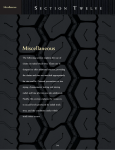
![Trailer Roll Stability (TRS) Installation Manual [L30040]](http://vs1.manualzilla.com/store/data/006020641_1-040a22153212ab13bbec744ca183c148-150x150.png)
